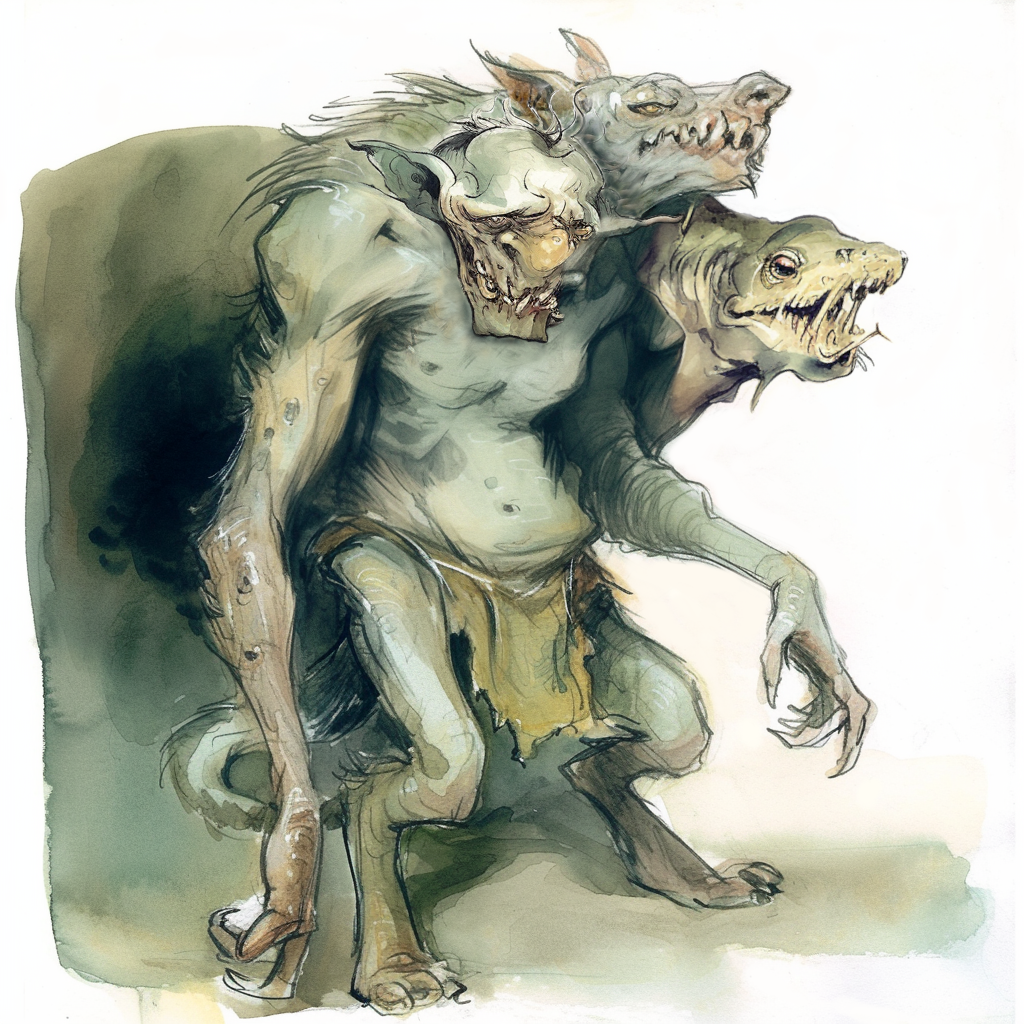Troyan

Triglav, The-One-With-Three-Heads. CE tanar’ri lord of conspiracy, pseudohistory, false secrets and xenophobia [He/They]
Pantheon: Slavic
Symbol: Three intersecting lines with curved ends
Realm: Abyss / Layer 369 — Duggur
Proxies: None
Have you expected a tanar’ri to be beautiful, berk? Troyan is covered in nasty matted fur, and his legs end with hooves. Quite expectedly for someone named “The-One-With-Three-Heads”, Triglav has three heads—the ugly humanoid one, the fiece wolf one and the terrifying pike one. All of them have goat ears, don’t ask why. Interestingly, while three heads have different personalities, they don’t actually hate each other. At least not openly. Each head constantly schemes against the others, but those plans are yet to come to any fruition—Troyan is a master of the Long Game.
Despite their looks, Troyan is a pretty civilised tanar’ri, all things considered. They are actually somewhat interested in how societies of other planes work, though this interest is obviously self-serving. Triglav is keen on creating chaos and evil by spreading hate, fear and lies. “You’re the greatest nation, true rulers of this world”, he whispers to the deluded and those who thrive on flattery, “but others have cheated you out of your destiny with fake histories and hideous lies. But you know the truth now, and you can take back what is rightfully yours”.
His cults are more like hate mobs, brought together by their mutual bigotry and self-aggrandizing beliefs. They often infiltrate other religions, especially small ones, where they can easily twist the doctrine to serve Troyan’s schemes. Sometimes they even create entire new cults. Quite often, their followers have no idea they are benefitting Troyan by sliding towards chaos and evil.
Triglav supplies his followers with enchanted Abyssal weaponry. When such a weapon hits a creature with a critical strike, there is a chance this may instantly banish them into Troyan’s Abyssal realm. If this weapon is broken, however, all targets banished by it within the last hour are returned to the place they were banished from. The claws of Troyan themself also have the same ability. They generally prefer to travel in humanoid disguise, but when it comes to combat, they are much more powerful in their true three-headed form. Troyan is huge and can grapple creatures with all three of their maws. They can also unleash a sonic blast that knocks enemies back. Troyan actively employs magics that cause discord and strife—mainly illusions and mind control.
Duggur — Abyssal Layer the 369th
This weird Abyssal layer is a sea of black ink, blanketed with toxic bluish mists. It is always shrouded in night and the full moon (although some say it’s a giant imprisoned demon) always hangs low in the sky, unmoving. Each of the islands in the inky sea are occupied by crowded cities, lit up by eerie blue lanterns. Architecture here is varied—buildings can look like Arborean temples, cases from Sigil, plain concrete geometrical shapes or weird demonic ziggurats, but they are always grim and grey. You will also find statues of Troyan, and other tanar’ri lords—each island burg seems to have its own favourites.
Most citizens are actually the enslaved victims of Troyan’s cult, many of whom are ironically, cultists of Troyan themselves, or manes. The tanar’ri high-ups, most of whom are nalfeshnee or succubi, constantly pit their minions against each other as they battle and scheme to take over each island. All of the island burgs of Duggur wage war continual against each other, although they rarely escalate into all-out combat, as sailing miles through the inky sea is dangerous and costly. The battle is mostly one of propaganda and lies, coupled with liberal use of portals or teleportation magic to pop in and strike at a rival burg with guerrilla-style attacks. It is not known where exactly Troyan lives—every burg claims itself to be their true chosen home.

Sources: Margarita and Jon Winter-Holt. Margarita notes: While this homebrew tanar’ri lord is based on Slavic folklore and beliefs, the amount of actual information we have on pre-Christian Slavic deities is so minuscule that building any kind of lore out of it is impossible. However, there are a lot of folk beliefs about things these deities are thought to represent, which I have worked into the piece.

